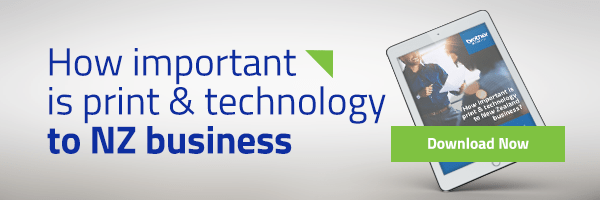
Business trends for the next 10 years: The Brother perspective
The way we work has changed significantly in the past decade. In 2009 few people had smartphones and people were much more tied to traditional, physical workplaces with print playing a significant role in information management.
So what will happen in the next 10 years? We take a look at what the workplace could look like in 2029.
In terms of print, it is reasonable to expect that advances in technology, pressure to reduce costs, and environmental responsibility would cause a reduction in print volumes for the next 10 years. However, this is not always the case.
Printing in the office continues to be a vital function for most New Zealand businesses, one that is essential to the successful operation of the business. Asked how the importance of printing compares to a year or two ago, those who believe it is more important actually outnumber those who think the opposite. So the trend seems to be towards, rather than away from printing.
The 2017 Brother New Zealand Business Print and Technology Survey shows that not only is printing still a regular part of the daily routine in offices, but most people have actually seen their print volumes increase over the past few years.
Businesses are still using physical files
Interestingly, the Brother survey shows 63 per cent of employees are using hard copy filing and recording keeping. Employers see admin and document management as the area where print adds the most benefit to their business.
Printers will continue to be important for business
Employees’ views on print highlight the importance of this function to their success in the job. In the Brother survey, a large majority (85 per cent) said printing was important or extremely important in their job. Nearly all of these people - 81 per cent of the total number of employees who responded - said that being able to print and scan at work makes them more efficient, while almost as high a number say it improves the quality of their work. 58 per cent of employees use the office printer every day, while a further 31 per cent say they print a number of times every week. So, a total of 89 per cent of New Zealand employees regularly print documents.
Flexible working
As property costs rise and technology makes remote working easier, work will increasingly be something we do, rather than somewhere we go. Research by the Chartered Institute of Personnel and Development showed that 70 per cent of managers believe it will be the main way of working by 2020.

The internet of things
We are already surrounded by intelligent, data-driven devices that help us with many aspects of work, but smartphones, tablets and wearable technology are just the beginning of business trends for the next 10 years. We’re set to see digitally connected technology controlling a lot more of our working environments, from security and meeting room booking to climate control and even ordering supplies for the office kitchen.
Virtual presence
To help connect an increasingly flexible workforce, we’ll continue to see improvements in video communication tools. Telepresence robots are already here, allowing people such as consultants, experts or team leaders to move around a space and interact virtually wherever they might be located.
Virtual reality
Goldman Sachs predicts that VR will be a $118 million ($NZD) market by 2025, and applications in the workplace are sure to follow. Virtual workspaces could allow a geographically distributed team to collaborate in the same way they would if they were sitting around the same boardroom table or bank of desks.
Expectations of millennial workers
According to a PwC report, by 2020, those born between 1980 and 2000 will make up 50 per cent of the global workforce. The research found that ‘digital native’ generation, which grew up with smartphones and social media, tend to be uncomfortable with rigid corporate structures, are turned off by information silos and want regular feedback and encouragement. This will have a major impact on the management styles required from leaders.
Summary
The continued power of print, the rise of flexible working, the dominance of technology as the primary agent of change: the business trends of the future are shaping up to change the face of doing work as we know it.




